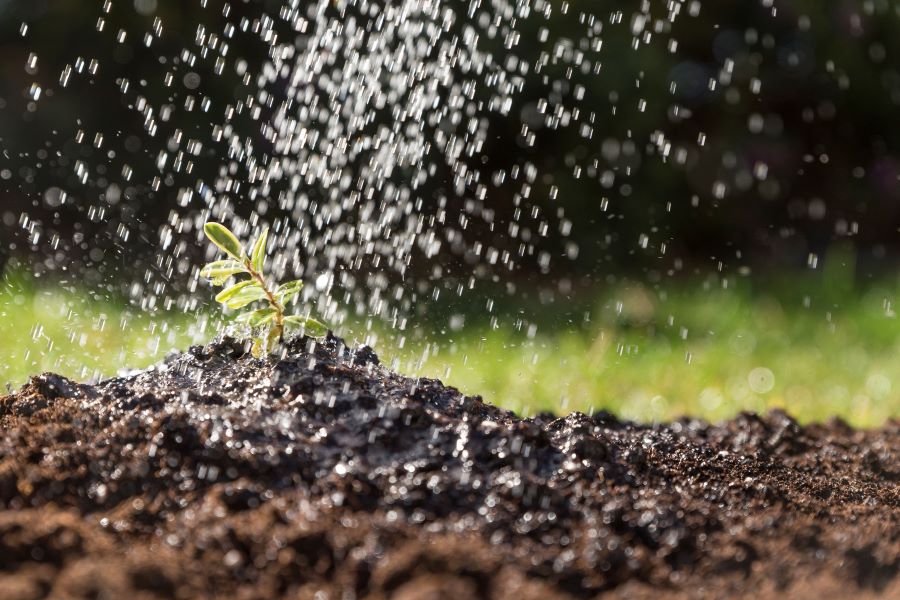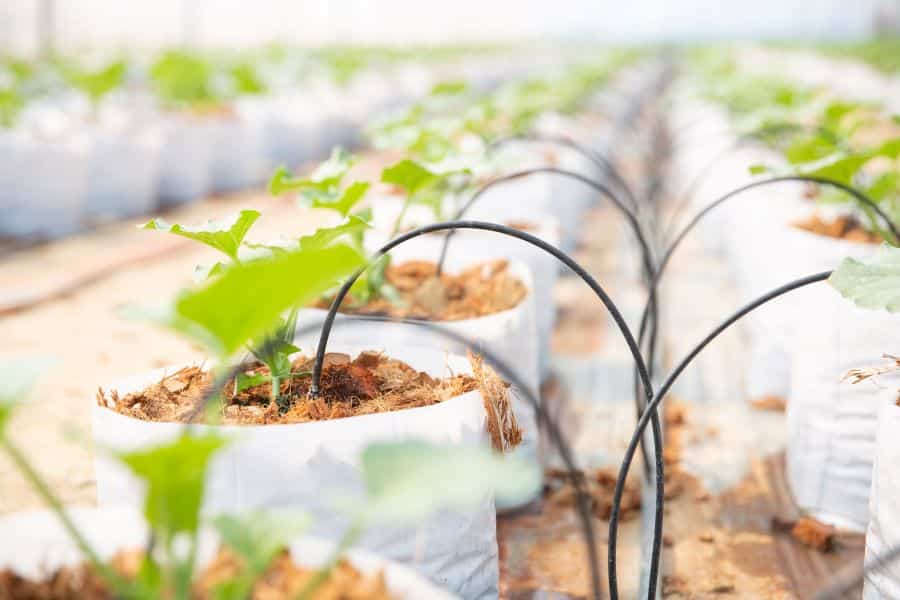Do you often find yourself engaged in a never-ending struggle with your hose, attempting to control the unruly spray and direct water precisely where your plants require it?
If so, there exists a significantly more serene and efficient method of watering your garden: the drip line!
What is a Drip Line?
Picture a slender, dark serpent meandering amidst your garden plots. Essentially, that’s what a drip line resembles! It is a slender tube commonly crafted from polyethylene, featuring small dispensers evenly distributed along its span. These dispensers function as miniature sprinklers, gradually delivering water directly to the root area of your plants.
Importance of Drip Lines in Irrigation
Conventional sprinkler systems tend to exhibit a considerable amount of wastefulness. They disperse water indiscriminately, reaching areas such as walkways, patios, and even portions of the atmosphere!
As a result of this process, water loss through evaporation and surface runoff occurs, which has significant implications for regions facing water scarcity and for our planet as a whole! Conversely, drip lines aim to deliver water precisely where it is needed the most—directly to the roots that crave hydration.
Want to unlock the water-saving power of drip irrigation for your garden? Contact Cacti Landscapes today!
Components of a Drip Line System
Establishing a drip line system is not overly complex, but it does require the coordination of several essential components.
Here is a breakdown of the fundamental elements involved:
- Valve: Serving as the control mechanism for the entire system, this device establishes a link between your hose or faucet and regulates the movement of water.
- Filter: The presence of minuscule particles within your water has the potential to obstruct the emitters. A filter functions as a protective shield by capturing any debris before it reaches the fragile drippers.
- Pressure regulator: The water pressure may differ based on the drip system you have in place. To maintain a steady and gentle flow, a pressure regulator helps to ensure that the water that flows into the drip lines will remain the same, eliminating any potential bursts and allowing even distribution of water.
- Backflow preventer: One of the most important features that plays a key role in keeping your supply of clean water is a backflow preventer. Allowing impure water to flow in just one direction, this unit ensures that your system’s water state will remain clean for a long time.
- Dripline: The main attraction! This is the hose, adorned with emitters, that gracefully winds its way through your garden.
- Emitters: These are small openings on the dripline that discharge water and are available in various flow rates to allow for customization based on the specific needs of your plants.
- End cap: Sealing the end of your dripline is necessary to ensure that water does not continuously escape after you have installed it.
Calculating Water Requirements for Drip Lines
The attractiveness of dripper lines resides in their accuracy. Unlike sprinklers, which uniformly saturate everything, you can tailor the water distribution for individual plants. To determine the appropriate amount of water required by your plants, it is important to take into account variables such as the type of plant, the quality of the soil, and the prevailing climate.
Conducting a brief online search or engaging in a conversation with a knowledgeable gardening professional can provide valuable insight into establishing the optimal watering schedule and duration for your particular circumstances.
Installing a Drip Line System
Setting up a drip system is a project that can be easily accomplished by do-it-yourself enthusiasts. Here is a simplified explanation:
- Outline your garden plot and determine the route of the dripper line. Take into account the arrangement of plants and the positioning of emitters.
- Construct the primary line by adhering to the manufacturer’s guidelines while joining the valve, filter, pressure regulator, and backflow preventer in sequence.
- Operate the dripline by placing it along your intended route, ensuring its stability with stakes if necessary.
- Depending on the drip line variant, you may need to puncture holes for the emitters or attach them directly to pre-existing openings.
- Establish a connection between the dripline by securely fastening it to the main line using suitable connectors.
- End the dripline by securely capping the open end with an end cap.
- Verify the functionality of the system by activating the water supply and inspecting for any signs of leakage or irregular water distribution. Make necessary modifications if required.
Types of Drip Line Emitters
There are primarily two categories of drip line emitters:
- Pressure compensating emitters: These devices ensure a consistent flow rate, unaffected by changes in water pressure. Ideal for gardens that have uneven landscapes.
- Non-compensating emitters: These emitters distribute water at a pre-established rate determined by their design. They are well-suited for even gardens where plants have comparable water requirements.
Troubleshooting Common Issues with Drip Lines
Even the best drip line system can encounter occasional hiccups. Here’s how to troubleshoot some common issues with drip lines:
- Clogged emitters: Blocked emitters can be cleared by utilizing a gentle acidic solution or employing a toothpick as a cleaning tool.
- Uneven water flow: To address inconsistent water distribution, it is essential to investigate potential leaks, verify appropriate pressure levels, and make necessary adjustments to emitters.
- Animal damage: Protection against animal-related harm can be ensured by utilizing wire mesh or fencing to safeguard the dripline if deemed necessary.
It is also important to pay attention to potential leak detection in irrigation systems. Keep in contact with Las Vegas landscapers to bring the best service to your irrigation system!
Advantages of Drip Irrigation
Drip irrigation tubing presents a wide array of advantages for both your garden and the surrounding ecosystem:
-
- Water conservation: Drip irrigation systems transport water directly to the plant roots, reducing both evaporation and runoff. This results in substantial water conservation, particularly in areas susceptible to drought.
- Adaptability: Versatility is a key characteristic of drip lines, as they prove to be highly adaptable. Whether it’s gardens with different dimensions, raised beds, potted plants, or even crop rows, drip lines can effectively cater to all these scenarios. The layout can be customized according to your requirements.
- Consistent water flow: Drip lines offer a gradual and consistent stream of water, facilitating an ideal uptake of moisture by the root zone. This mitigates the chances of insufficient or excessive watering, thereby fostering robust plant development.
- Improved plant growth: Through the direct delivery of water to the root system, drip irrigation systems guarantee that plants receive adequate moisture necessary for robust growth. This results in improved plant vitality, more resilient stems, and possibly even higher crop yields.
- Weed control: Drip irrigation aids in weed control by efficiently delivering water to the root zone of plants, discouraging the growth of unwanted weeds. This allows gardeners to devote more time to appreciating their lovely garden rather than constantly battling with weed issues.
- Minimized pollution and territorial damage: Conventional sprinkler systems have the potential to cause water runoff, which can transport fertilizers and pesticides into adjacent water bodies. Drip irrigation mitigates this possibility, fostering a more environmentally conscious method of gardening.
- Time efficiency: This is achieved when you have successfully established your drip line system, allowing you to experience the convenience of automated irrigation. This eliminates the need for laborious tasks such as dragging tubes and hoses or manually watering each plant.
-
- Minimized risk of plant fungus: In plants, fungal diseases typically flourish when there is a persistent presence of moisture on the leaves and stems. By watering the root zone directly, drip lines assist in maintaining drier foliage, thereby minimizing the likelihood of fungal issues. Plants such as tomatoes and roses, which are prone to fungal infections, can significantly benefit from this practice.
Drip irrigation can help you save water and nurture your plants. Explore your possibilities by contacting professionals in landscaping in Henderson!
To Recap, drip lines have revolutionized the way gardeners conserve water, improve plant well-being, and streamline their watering regimen. With their precise delivery system and effortless setup process, drip lines present numerous benefits over conventional methods of irrigation. Regardless of whether you possess advanced gardening knowledge or are venturing into it for the first time, utilizing drip irrigation can enable you to establish a flourishing oasis without incurring excessive costs or squandering valuable resources. Therefore, abandon the traditional hose method and embrace the effectiveness and advantages of drip lines to foster a sustainable and fulfilling gardening endeavor.





